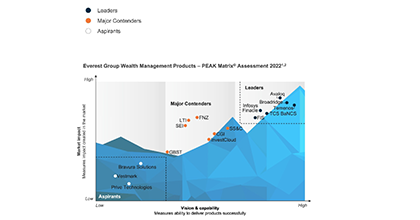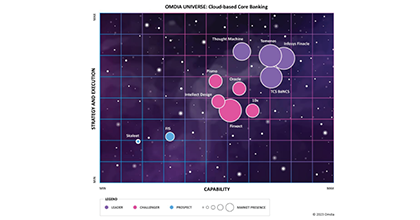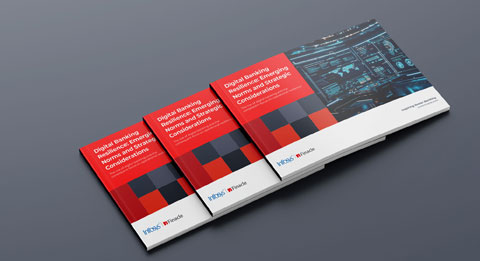-
![]() ESG in bankingESG-conscious banking should create new and future-proof value streams to build a sustainable and resilient business.Read More
ESG in bankingESG-conscious banking should create new and future-proof value streams to build a sustainable and resilient business.Read More -
![Everest Group PEAK Matri Everest Group PEAK Matri]() Everest Group PEAK MatrixA comprehensive solution delivering a full spectrum of wealth products as great experiences. It also improves the productivity of financial advisors and streamlRead More
Everest Group PEAK MatrixA comprehensive solution delivering a full spectrum of wealth products as great experiences. It also improves the productivity of financial advisors and streamlRead More -
![]() Subsidiary of an American Bank in IndonesiaFind out how a leading American bank adapts to a digitalized trade and supply chain finance operations as a part of its larger transformation by leveraging Finacle Trade Finance Solution Suite.Read More
Subsidiary of an American Bank in IndonesiaFind out how a leading American bank adapts to a digitalized trade and supply chain finance operations as a part of its larger transformation by leveraging Finacle Trade Finance Solution Suite.Read More
-
![]() Recomposing Banking: Leading the Digital ContinuumReport gives you a glimpse of the major areas where recomposing banking will create significant impact and value, Infosys Finacle has put together a report on..Read More
Recomposing Banking: Leading the Digital ContinuumReport gives you a glimpse of the major areas where recomposing banking will create significant impact and value, Infosys Finacle has put together a report on..Read More -
![]() Core Banking on Cloud: Navigating to the Fast LaneTake a deep dive into cloud-based core banking and explore the imperatives, opportunities and challenges, and the hallmarks of a robust solution.Read More
Core Banking on Cloud: Navigating to the Fast LaneTake a deep dive into cloud-based core banking and explore the imperatives, opportunities and challenges, and the hallmarks of a robust solution.Read More -
![]() Embracing Payments ComposabilityA step-by-step guide for maximizing Real Time Payment opportunities by embracing Payments Composability...Read More
Embracing Payments ComposabilityA step-by-step guide for maximizing Real Time Payment opportunities by embracing Payments Composability...Read More
-
![]() Shaping Banking’s Next: Banking Technology Trends for 2025 and BeyondThe banking industry has been balancing disruption and opportunity for several years now, and the pace of change shows no signs of slowing as we move into 2025 and beyond.Read More
Shaping Banking’s Next: Banking Technology Trends for 2025 and BeyondThe banking industry has been balancing disruption and opportunity for several years now, and the pace of change shows no signs of slowing as we move into 2025 and beyond.Read More -
![]() Virtual Accounts 2.0: Surpass Conventional Cash Management and Unlock Next-Gen PossibilitiesVirtual Account Management was a groundbreaking shift in the banking landscape, revolutionising use cases like cash concentration, pooling, centralised treasury management, and in-house banking (POBO, ROBO, COBO)Read More
Virtual Accounts 2.0: Surpass Conventional Cash Management and Unlock Next-Gen PossibilitiesVirtual Account Management was a groundbreaking shift in the banking landscape, revolutionising use cases like cash concentration, pooling, centralised treasury management, and in-house banking (POBO, ROBO, COBO)Read More -
![]() Unlocking Hybrid CloudAs banks push forward with their digital transformation agenda, cloud serves as a pivotal enabler. Each bank, at varying stages of adoption, crafts its unique path, dictated by context, regulations, and risk appetite.Read More
Unlocking Hybrid CloudAs banks push forward with their digital transformation agenda, cloud serves as a pivotal enabler. Each bank, at varying stages of adoption, crafts its unique path, dictated by context, regulations, and risk appetite.Read More
-
![]() Banking on CloudThis report from Infosys Finacle delves into the need for accelerating cloud adoption, highlights the current state of the industry, and puts forth key recommenRead More
Banking on CloudThis report from Infosys Finacle delves into the need for accelerating cloud adoption, highlights the current state of the industry, and puts forth key recommenRead More -
![]() Omdia Universe | Cloud-based Core BankingIn the report, Omdia highlights the following key capabilities of leading cloud-based core banking providers:Read more
Omdia Universe | Cloud-based Core BankingIn the report, Omdia highlights the following key capabilities of leading cloud-based core banking providers:Read more
-
![]() Emirates NBDEmirates NBD consolidates its operations on a single version for scalability, agility, and standardization.Read More
Emirates NBDEmirates NBD consolidates its operations on a single version for scalability, agility, and standardization.Read More -
![]() A Global Top 5 BankDiscover how a global top 5 bank headquartered in the US accelerated payments transformation.Read More
A Global Top 5 BankDiscover how a global top 5 bank headquartered in the US accelerated payments transformation.Read More -
![]() Union Bank of IndiaUnion Bank of India launches Union Virtual Connect (UVConn) by leveraging WhatsApp to provide customers personalized banking services.Read More
Union Bank of IndiaUnion Bank of India launches Union Virtual Connect (UVConn) by leveraging WhatsApp to provide customers personalized banking services.Read More

Adapt or Die: How Banks Can Survive in the Age of Embedded Finance and Decentralized Finance
Blogs
The future of banking is rapidly changing in response to technological advancements, shifting customer expectations, and increased competition from fintech firms. Banks are no longer the gatekeepers of financial transactions and are instead shifting towards becoming facilitators for transactions between various parties. Three key trends are driving the future of banking transactions: embedded finance, decentralized finance (DeFi), and the growing trend towards the central banks of several countries experimenting with central bank digital currency (CBDC).
Embedded Finance
Embedded finance refers to the integration of financial services into non-financial products and services, allowing customers to access financial services through the products they already use. For example, a customer may be able to access loans or insurance through a ride-sharing app, rather than through a traditional bank.
Embedded finance is a win-win for all stakeholders involved. Customers benefit from frictionless banking experiences, such as the ability to make purchases using buy now, pay later (BNPL) options. Merchants and brands also benefit from the ability to attract customers with digital financing options and expand their business. Banks, on the other hand, can expand their services to more customers without incurring the costs of distribution.
Progressive banks are approaching embedded finance with a product management mindset. They are building ecosystems of digital platforms, fintechs, e-commerce players, and other entities to offer a wide range of financial services to their customers. This enables them to offer new products and services, such as digital wallets, mobile payments, and other digital financial services in a cost-effective way. By partnering with digital platforms, banks can also gain access to new customers and markets that were previously out of reach. In addition, embedded finance enables banks to increase revenue from existing customers by providing them with additional services such as lending and insurance. This allows them to increase customer loyalty and retention.
DeFi
Decentralized finance refers to the use of blockchain technology to create decentralized financial platforms and services that operate independently of traditional financial institutions. DeFi platforms provide customers with greater access to financial services, such as lending, borrowing and trading, and provide increased transparency and security through the use of smart contracts.
One of the key advantages of DeFi is that it’s built on blockchain technology, which allows for secure, transparent, and tamper-proof transactions. This creates a trustless and decentralized environment for financial transactions, which means that there’s no central authority that controls the system, making it more resistant to censorship and fraud. DeFi also enables greater access to financial services for individuals and businesses that may not have access to traditional banking services. This includes those in emerging economies, as well as underbanked or unbanked populations.
However, DeFi also poses some challenges, such as the lack of regulatory oversight and the potential for security risks. While still in its early stages, DeFi has the potential to revolutionize the way that financial services are provided and consumed.
CBDC
Central bank digital currency refers to digital versions of fiat currencies issued and backed by central banks. One of the key advantages of CBDCs is that they have the potential to enhance financial inclusion by providing access to digital payments for those who may not have access to traditional banking services. This could be particularly beneficial for individuals and businesses in emerging economies or for underbanked or unbanked populations.
CBDCs also have the potential to simplify cross-border transactions by providing a unified digital currency for countries to use, reducing the need for currency conversions and exchange rate fluctuations. This could also reduce transaction times and costs, making international trade more efficient.
However, there are also security and privacy concerns surrounding CBDCs, including the risk of hacking and the potential for governments to monitor citizens’ financial transactions. It’s important for central banks and governments to address these concerns and ensure that any implementation of CBDCs is done with proper security measures in place.
Key Takeaway
In summary, embedded finance, decentralized finance, and central bank digital currency are all key trends that are driving the future of banking. These trends are providing customers with new ways to access financial services and providing new opportunities for financial innovation. Banks must adapt to these changes to remain competitive in the future.
This article was previously published in Payments Journal.


©2025 -Edgeverve Systems Limited | All rights reserved


















